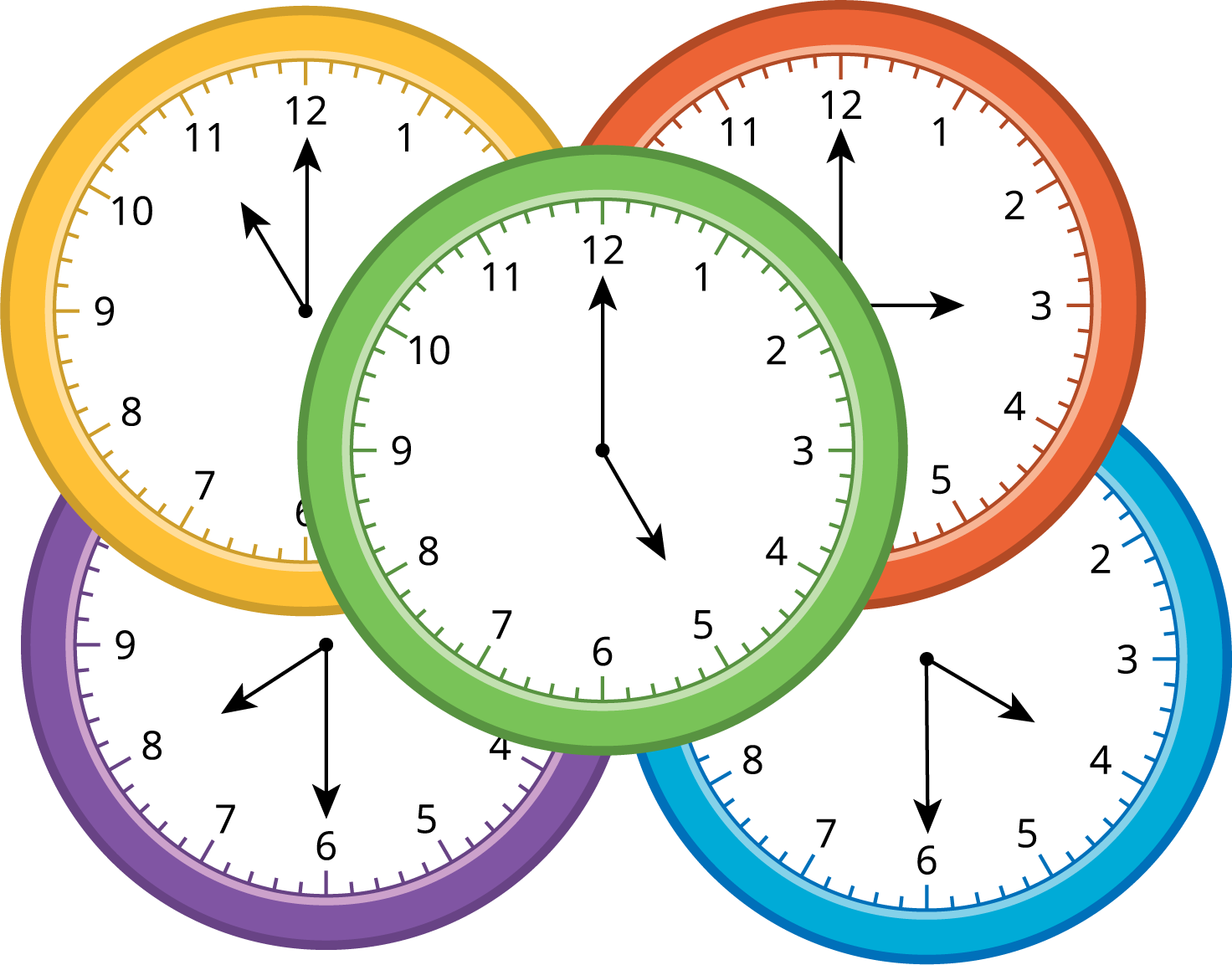Lesson 16
Hard Times
Warm-up: Number Talk: Tens and Ones (10 minutes)
Narrative
Launch
- Display one expression.
- “Give me a signal when you have an answer and can explain how you got it.”
- 1 minute: quiet think time
Activity
- Record answers and strategies.
- Keep expressions and work displayed.
- Repeat with each expression.
Student Facing
Find the value of each expression mentally.
- \(8 + 32\)
- \(8 + 33\)
- \(8 + 38\)
- \(8 + 48\)
Student Response
For access, consult one of our IM Certified Partners.
Activity Synthesis
- “Who can restate _______ 's reasoning in a different way?”
Activity 1: What’s the Time? (15 minutes)
Narrative
Advances: Speaking
Required Materials
Materials to Gather
Required Preparation
- Each student needs both the Hour Clock Cards and Half Hour Clock Cards from previous lessons.
Launch
- Groups of 2
- Give each student their clock cards from previous lessons.
- “From your pile of cards, take out 12:00, 12:30, 6:00, 6:30.”
- Display these clocks.
- “How are these clocks the same and different?” (They have hour and minute hands. They have arrows pointing to 12 or 6.)
- “What time does each clock show? How do you know?” (12:00, 12:30, 6:00, 6:30. I look at where the hour hand points and then see if it’s ‘o’clock’ or ‘half-past’ based on the minute hand.)
- “You are going to play a game with your partner using all your cards. Hold up a clock card for your partner and cover up the written time. Your partner reads the time and you check what they say with the time on the card. Then switch roles.”
Activity
- 10 minutes: partner work time
Activity Synthesis
- “What makes some of the times harder to read?”
Activity 2: What’s the Time, Again? (10 minutes)
Narrative
Launch
- Groups of 2
- Display the clock in the first problem.
- “Diego and Priya read the clock and got two different times.”
- “Who is correct? How do you know?”
Activity
- 2 minutes: partner discussion
- 5 minutes: independent work time
- Monitor for a student who says the hour hand is pointing to 6 and one who says that for 12:30 the hour hand should be between 12 and 1.
Student Facing
-
Diego says this clock shows 6:00.
Priya says the clock shows 12:30.
Who do you agree with? Why?
Synthesis:


Student Response
For access, consult one of our IM Certified Partners.
Activity Synthesis
- Invite previously identified students to share.
- “Why do you think Priya got mixed up? What could you say to help her revise her thinking?” (Priya mixed up the minute and hour hands. I could remind her that the short hand is the hour and the long hand is the minute. I could remind her that if it was 12:30 the hour hand would have to be between two numbers.)
- “On the blank clock, draw hands to show 12:30.”
Activity 3: Sunday Schedule (10 minutes)
Narrative
Supports accessibility for: Organization, Conceptual Processing
Launch
- Groups of 2
- “What are your favorite things to do on a Sunday?” (I like to go to the park, eat lunch, take a nap, and read a book.)
- 30 seconds: quiet think time
- 1 minute: partner discussion
- Share and record responses.
Activity
- “Fill in the blanks for your ideal Sunday schedule. Then share with your partner.”
- 4 minutes: independent work time
- 2 minutes: partner discussion
- Monitor for a student who has an activity at 12:30.
Student Facing
Fill in the blanks to show your ideal Sunday schedule.
Time
Activity
Clock











Student Response
For access, consult one of our IM Certified Partners.
Activity Synthesis
- Invite previously identified students to share.
- Display students’ schedules, covering up the digital clocks and asking the class to tell the times.
Lesson Synthesis
Lesson Synthesis
“In this unit, we studied shapes, split shapes into equal parts, and learned to tell time. What did you like best in this unit? Why?”
Cool-down: Draw the Clock (5 minutes)
Cool-Down
For access, consult one of our IM Certified Partners.
Student Section Summary
Student Facing
We learned how to tell time to the hour and half hour.
We learned when the minute hand points to the 12, the hour hand points to a number. We say “___ o’clock.”


We learned when the minute hand has gone half way around the clock and points to the 6, the hour hand points halfway between 2 numbers. We say “half past ___.”


We learned how to write time.


